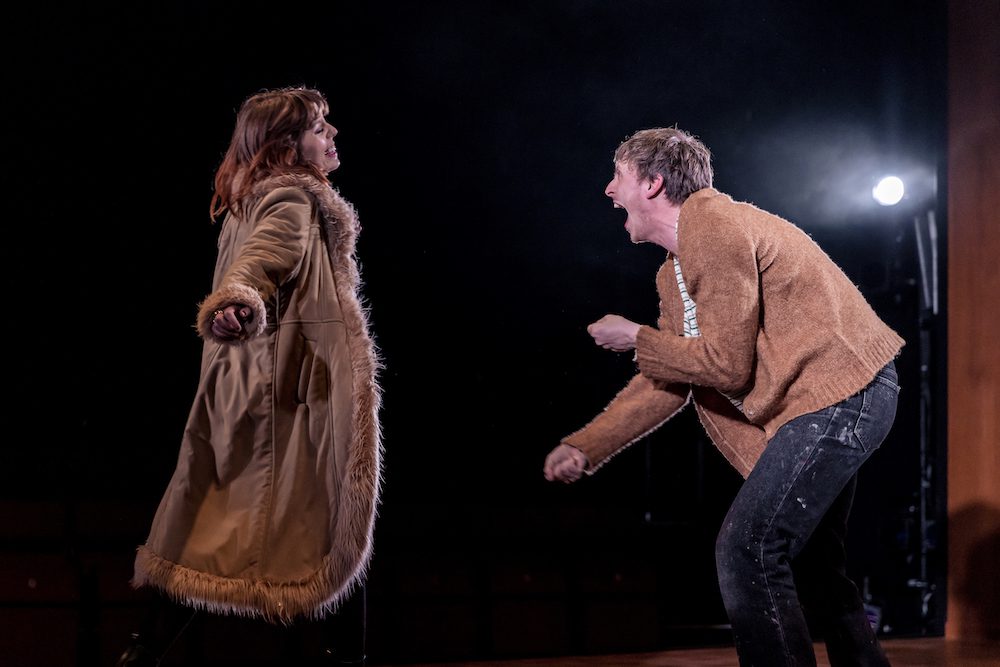Anyone who has ever drunk to blackout – i.e. forgotten what they did the night before – will know that the first question they ask their friends the next day is “What did I do last night?” If they are really honest, they will ask themselves “Who was I last night?” And if they want to delve further the question becomes “Is who I am when I lose myself so completely the real me?”
In Blackout Songs, two artists – a painter and a writer – meet at an Alcoholics Anonymous meeting. It does not end in clarity or sobriety for either of them.
As their relationship develops it also spirals. their dependency on booze is what they have in common, but their dependency on each other is at once more toxic and more tenuous. Do these two people – who, in a mimicry of the anonymity of their meeting go unnamed throughout – ever really get to know each other’s depths? Or do they just cling to the parts that enable each other to make the alcoholic’s excuse for one last drink, one last time – repeated ad nauseam?
The two display two very different types of drinker. She is the gregarious, fun drunk and he the shy artist whose Dutch courage has become a necessity for social interaction. These stereotypes are quite gendered, but I think we have all seen them play out in what is, after all, a world in which such sex stereotypes might lead just such people to drink.
The mythos surrounding artists and drink is a strong one. Imagine Hemmingway without whisky or Van Gogh without a carafe of wine. Some artists will tell you they have to lose themselves in one substance or another in order to unlock and reveal the soul within. The need to destroy themselves in the name of art has often been portrayed as noble or otherworldly. Artists are different creatures, unbound by the mundanity of the rest of us – and unwilling to play by our rules.
But as we watch these two descend, rise again and inevitably fall, the strength of the writing is precisely in the mundanity of their existence. Stealing communion wine is hardly an act of great artistic achievement or living their best lives. It is only when the drinking is briefly tamed – and their relationship abandoned – that either of them achieves any success. Separately, they might be able to carry on. Together they are as toxic as the poisons coursing through their bodies, killing them painfully and not particularly slowly.
Humphries captivates as the charming, fun and funny good-time girl at the heart of the play. She retains a lightness of touch that makes you understand that despite everything she is genuinely fun to be around. Austin has a harder time as his character is at once moody and diffident and at times it is harder to understand the reasons she keeps going back. Is it just the co-dependency?
The set is sparse – just wood panelling and chairs to resemble any church hall where their initial meeting might have taken place. But the imaginative way that Director Guy Jones uses the fluidity of the actors against the rigidity of those chairs offers an approach to portraying drunkenness that an audience can truly appreciate. There was little slurring in the actor’s diction for the most part. Their drunkenness was portrayed through their actions and their choices rather than exaggerated mannerisms or comic pratfalls.
Blackout Songs can be a little unrelenting at times and might have been tighter if it had been slightly shorter. We definitely needed to see the two spiral, but in doing so again and again, I think some of that lost its impact.
However, the play gives a scarily realistic take on the power that losing ourselves to drink can have over those inclined to want to do so just a little too much. The passion the two show for each other is undercut beautifully by the fact that they often know they are dragging the other down and care less for their lover than they do for the bottle.
This is a powerful depiction of two relationships gone bad: That between the protagonists themselves, and the characters and booze. The drink that once gave such pleasure has only ended in relentless pain, and yet they cannot – or will not – tear themselves from the bottle or each other. They will lie to each other constantly to try to get one more hit. What is fascinatingly portrayed here is the open question: How much are they also lying to themselves?

